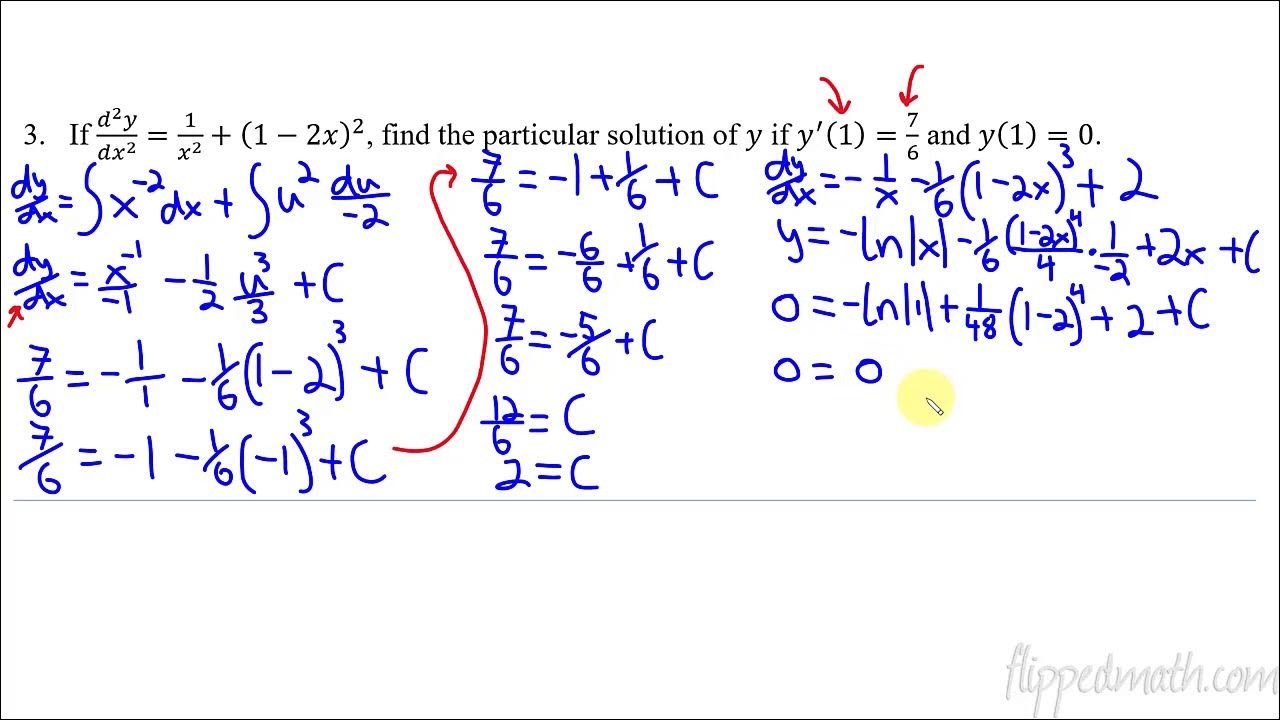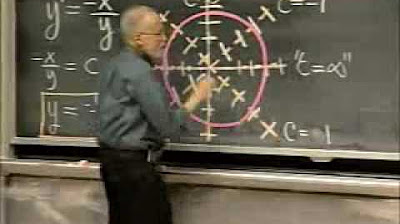Checking Solutions in Differential Equations (Differential Equations 3)
TLDRThis transcript outlines a lesson on differential equations, focusing on verifying solutions. The instructor explains that solutions are equations themselves and emphasizes the importance of matching derivatives when plugging them into the differential equation. The lesson progresses through various examples, including first and second-order differential equations, and highlights the use of calculus rules such as the chain rule and product rule. The goal is to demonstrate the process of checking if a given function is a solution to a differential equation by substituting the derivatives back into the equation and verifying the result.
Takeaways
- 📚 Differential equations involve derivatives and their solutions are usually functions of X, often denoted as y = f(X).
- 🔍 To verify if a solution is correct, substitute the function and its derivatives into the differential equation and check for equality.
- 📈 The order of the differential equation determines the number of derivatives needed to verify a solution (e.g., first-order requires one derivative, third-order requires three).
- 🌟 Examples are crucial for understanding; after grasping the concept, moving on is encouraged, but persistence with examples is beneficial for solidifying understanding.
- 📝 When checking solutions, be aware of calculus rules like product rule, quotient rule, and chain rule.
- 🔧 The process of checking solutions involves taking derivatives, substituting them into the equation, and simplifying to confirm if the solution holds.
- 🔄 For higher-order differential equations, there can be multiple solutions and arbitrary constants involved.
- 🧠 Practice is essential; attempting problems without guidance after understanding the concepts can reinforce learning.
- 📊 The script walks through several examples, including second-order differential equations and the application of product rules.
- 👉 The importance of checking work and carefully handling signs during the simplification process is emphasized to avoid errors.
- 🚀 The ultimate goal is to understand the process of verifying solutions and to be able to apply it to various types of differential equations.
Q & A
What is the main topic of the lesson?
-The main topic of the lesson is how to verify whether a given equation is a solution to a differential equation.
What type of differential equation is discussed first in the lesson?
-The first differential equation discussed is a first-order differential equation, y' + 2y = 0.
How does the process of checking a solution to a differential equation work?
-The process involves taking the necessary derivatives of the proposed solution, plugging them into the differential equation, and verifying if the resulting expression equals zero.
What are the rules mentioned that are important to know when taking derivatives in this context?
-The rules mentioned include the product rule, quotient rule, and chain rule for taking derivatives of functions.
How does the lesson handle the concept of arbitrary constants in solutions?
-It mentions that higher-order differential equations involve more arbitrary constants and thus have more potential solutions.
What is the significance of checking multiple solutions in a second-order differential equation?
-Checking multiple solutions is important because it verifies the validity of each proposed solution, ensuring they all satisfy the differential equation.
What is the role of the chain rule in this lesson?
-The chain rule is used to find the derivative of functions that are composed of other functions, such as y = e^(-2x) or y = cos(Ln(x)).
How does the lesson emphasize the importance of simplification in solving differential equations?
-The lesson stresses that simplification is crucial for correctly solving and verifying solutions to differential equations, as it helps to avoid sign errors and clarify the expressions.
What is the purpose of practicing examples in the lesson?
-Practicing examples helps to reinforce the understanding of differential equations and the process of checking solutions, as well as to apply the rules of differentiation effectively.
What advice does the instructor give for students who are struggling with the material?
-The instructor encourages students to pause the video and try the examples on their own, as well as to review study techniques for math if they need additional support.
What is the final piece of advice given in the lesson?
-The final advice is to continue practicing with different types of solutions and to watch further videos to learn more about solving differential equations.
Outlines
📚 Introduction to Differential Equations
This paragraph introduces the concept of differential equations, emphasizing that they involve derivatives and that solutions are equations themselves. The speaker plans to provide many examples to ensure understanding and encourages viewers to move on if they grasp the concepts quickly. The first example involves a first-order differential equation, and the process of checking a solution involves taking derivatives and plugging them into the equation.
🧠 Checking Solutions for Differential Equations
The speaker explains the process of checking solutions for differential equations, using a second-order equation as an example. The explanation includes finding the first and second derivatives of given functions and plugging them into the differential equation to verify if they satisfy the equation. The speaker also mentions the increase in arbitrary constants and potential solutions as the order of the differential equation increases.
🔢 Solving Second-Order Differential Equations
This paragraph delves into solving second-order differential equations, with the speaker demonstrating how to find and verify solutions. The process involves taking multiple derivatives and carefully applying rules such as the product rule. The speaker emphasizes the importance of checking work for accuracy and provides a detailed walkthrough of the calculations involved in verifying solutions.
📈 Advanced Solution Verification
The speaker presents a more advanced example of verifying solutions for a second-order differential equation. The explanation includes taking derivatives of functions involving natural logarithms and simplifying the resulting expressions. The speaker carefully works through the process, highlighting the importance of correct simplification and the use of parentheses to avoid sign errors.
🌀 Complex Functions and Differential Equations
In this paragraph, the speaker tackles the verification of solutions involving complex functions, such as those with trigonometric and logarithmic components. The explanation covers the application of chain and product rules for derivatives, and the process of simplifying expressions involving trigonometric identities and logarithmic functions. The speaker emphasizes the importance of understanding the underlying mathematical concepts to successfully verify solutions.
🎓 Wrapping Up and Future Lessons
The speaker concludes the lesson by summarizing the process of understanding and verifying solutions for differential equations. They encourage viewers to practice the techniques learned and预告 upcoming videos that will cover different types of solutions and alternative approaches to differential equations. The goal is to reinforce the fundamental concepts and prepare viewers for more advanced topics.
Mindmap
Keywords
💡Differential Equations
💡Derivatives
💡Solutions
💡Chain Rule
💡First-order Differential Equation
💡Second-order Differential Equation
💡Product Rule
💡Verification
💡Arbitrary Constants
💡Trigonometric Functions
Highlights
The lesson focuses on understanding and checking solutions for differential equations.
Differential equations involve derivatives and solutions are typically equations themselves, usually in the form of y equals a function of X.
The process of checking a solution involves taking derivatives and plugging them into the differential equation.
The first example given is a first-order differential equation: y prime plus two y equals zero.
To check a solution, match up the derivatives and plug them into the differential equation.
For higher-order differential equations, more arbitrary constants are involved, leading to a greater possibility of different solutions.
The example of a second-order differential equation with two potential solutions, y sub one and y sub two, is discussed.
The importance of understanding calculus rules like product rule, quotient rule, and chain rule when working with differential equations is emphasized.
The process of checking solutions is demonstrated with a detailed example involving the function y equals negative two times e to the negative 2x.
The video encourages pausing to try solving examples independently as a study tool.
A second-order differential equation with two functions multiplied together is used to illustrate the product rule in action.
The importance of careful simplification and checking work when dealing with derivatives and differential equations is highlighted.
The video concludes with an encouragement to practice and review the material to prepare for more advanced topics in differential equations.
The process of taking derivatives and plugging them into the differential equation is reiterated as the method for checking solutions.
The lesson aims to provide a fundamental understanding of differential equations and their solutions.
The next video will cover finding different types of solutions for differential equations.
Transcripts
Browse More Related Video

First Order Linear Differential Equations

Introduction to Initial Value Problems (Differential Equations 4)

Calculus AB/BC – 7.2 Verifying Solutions for Differential Equations

AP Calculus Differential Equations Review (All of Unit 7)

The Theory of 2nd Order ODEs // Existence & Uniqueness, Superposition, & Linear Independence

Lec 1 | MIT 18.03 Differential Equations, Spring 2006
5.0 / 5 (0 votes)
Thanks for rating: